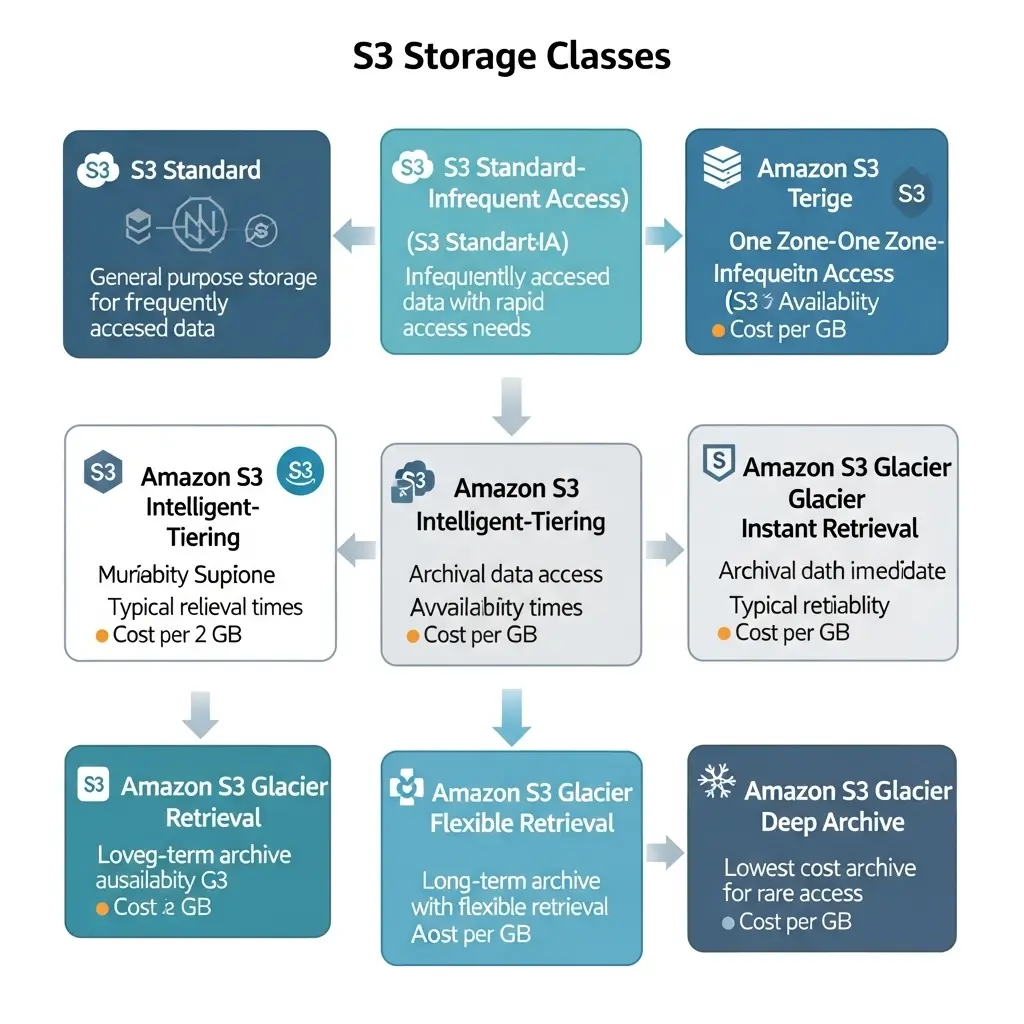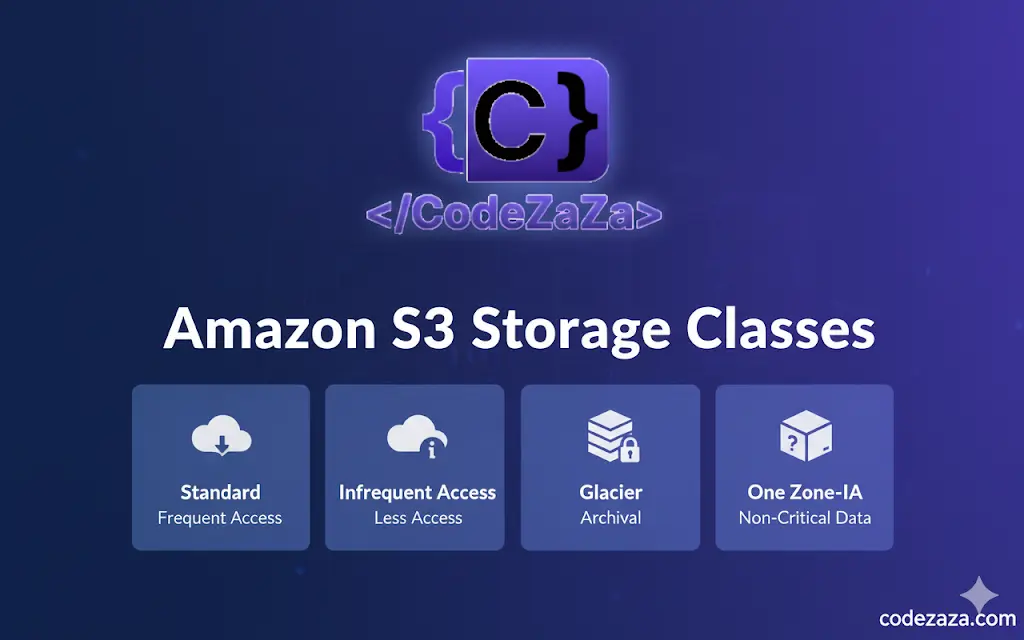When we think about the internet today, one thing is clear — data is everywhere. From photos and videos to documents, backups, and apps, we’re creating huge amounts of information every single day. But storing all this data isn’t just about keeping it safe; it’s also about storing it in a smart and cost-effective way.
That’s where Amazon S3 (Simple Storage Service) comes in. It’s one of the most popular cloud storage services in the world, and the best part is that it doesn’t follow a “one-size-fits-all” approach. Instead, it offers different storage classes — like different buckets designed for different types of data. Some classes are great for data you use often, while others are perfect for files you rarely touch but still want to keep safe for the future.
In this blog, we’ll break down these S3 storage classes in plain language, explain when to use each one, and show you how choosing the right option can save both money and effort.

1. S3 Standard
Amazon S3 Standard is the default storage class in Amazon S3 and is designed for data that you need to access often. It automatically stores your data across at least three different Availability Zones (AZs), which means your files are safe even if one or two locations experience an issue. This built-in redundancy gives you high durability and availability, making it a reliable choice for everyday workloads.
One of the biggest advantages of S3 Standard is its high performance and low latency. This means that whenever you or your applications request a file, it can be retrieved instantly without delays. Because of this speed, it’s ideal for websites, mobile apps, content distribution, big data analytics, and real-time applications where quick access to data is critical.
If you’re looking for a balance between performance, availability, and security, S3 Standard is the go-to option. While it may not be the cheapest storage class, it provides the best experience for frequently used data, ensuring your business applications run smoothly and your users get fast, uninterrupted access to information.
2. S3 Standard-Infrequent Access (S3 Standard-IA)
Amazon S3 Standard-Infrequent Access, commonly called S3 Standard-IA, is designed for data that you don’t need to access often but still want to keep safe and available when required. Like S3 Standard, it stores your data across at least three different Availability Zones (AZs), ensuring durability and protection even during failures. The main difference lies in the pricing model—S3 Standard-IA offers lower storage costs compared to S3 Standard, but you pay a higher retrieval cost whenever you access your files.
This makes S3 Standard-IA perfect for backups, disaster recovery files, long-term project data, or archives that you don’t use daily but can’t afford to lose. It provides the same level of availability, reliability, and performance as S3 Standard, just optimized for cost savings when data access is infrequent. If your organization is looking to reduce storage expenses while keeping critical data secure and instantly accessible when needed, S3 Standard-IA is a smart choice.
3. Amazon S3 One Zone-Infrequent Access (S3 One Zone-IA)
- Stores data in a single Availability Zone
- Has a lower storage price than Amazon S3 Standard-IA
Compared to Amazon S3 Standard and Amazon S3 Standard-IA, which store data in a minimum of three Availability Zones, Amazon S3 One Zone-IA stores data in a single Availability Zone. This reduces costs even further but comes with slightly lower durability compared to S3 Standard-IA. This makes it a good storage class to consider if the following conditions apply:
- You want to save costs on storage.
- You can easily reproduce your data in the event of an Availability Zone failure.
4. Amazon S3 Intelligent-Tiering
- Ideal for data with unknown or changing access patterns
- Requires a small monthly monitoring and automation fee per object
This intelligent storage class automatically manages data placement between different S3 access tiers (Standard, S3 Standard-IA, and Glacier) based on its access patterns.
In the Amazon S3 Intelligent-Tiering storage class, Amazon S3 monitors objects’ access patterns. If you haven’t accessed an object for 30 consecutive days, Amazon S3 automatically moves it to the infrequent access tier, Amazon S3 Standard-IA. If you access an object in the infrequent access tier, Amazon S3 automatically moves it to the frequent access tier, Amazon S3 Standard. This helps optimize costs for data with unknown or changing access needs.
5. Amazon S3 Glacier Instant Retrieval
- Works well for archived data that requires immediate access
- Can retrieve objects within a few milliseconds
Amazon S3 Glacier is Archivel Storage. When you decide between the options for archival storage, consider how quickly you must retrieve the archived objects.
- Storage Cost: This is where Glacier Instant Retrieval shines. It offers significantly lower storage costs, up to 68% cheaper compared to S3 Standard-Infrequent Access (S3 Standard-IA). This makes it perfect for long-term archival of data that you rarely access.
- Retrieval Cost: There’s a trade-off for the lower storage cost. Retrieving data from Glacier Instant Retrieval incurs a higher cost per GB compared to S3 Standard. This is because Glacier Instant Retrieval prioritizes keeping data readily available for quick retrieval while archived.
6. Amazon S3 Glacier Flexible Retrieval
Amazon S3 Glacier Flexible Retrieval is a low-cost storage class designed specifically for long-term archiving of data that you don’t need on a regular basis. It’s a great choice for files like customer records, medical images, historical documents, backups, or old photos and videos that you want to keep safe but rarely access. By storing your data in Glacier Flexible Retrieval, you significantly reduce storage costs compared to frequently accessed classes like S3 Standard or S3 Standard-IA.
What makes this class “flexible” is the range of retrieval options it offers. Depending on how urgently you need your data, you can choose from retrieval speeds that range from just a few minutes to several hours. For example, if you need quick access, you can pay a little extra for faster retrieval. If speed isn’t critical, you can opt for slower, cheaper retrieval options. This flexibility allows businesses to balance cost savings and accessibility based on their actual needs
7. Amazon S3 Glacier Deep Archive
Amazon S3 Glacier Deep Archive is the most cost-effective storage class in the AWS Cloud, designed for data that you rarely, if ever, need to access. It is perfect for long-term retention and digital preservation of information, such as compliance records, financial data, scientific research, or media archives that may only be accessed once or twice a year. Because of its extremely low storage price, Deep Archive is often used as a replacement for traditional tape storage solutions.
Data stored in Glacier Deep Archive is replicated across at least three geographically separated Availability Zones (AZs), ensuring durability and protection against hardware or site failures. However, the trade-off for this low cost is retrieval time. Accessing files typically takes 12 hours or more, with some retrievals extending up to 48 hours, depending on the option you choose. This makes it unsuitable for active workloads but highly efficient for long-term data that must be kept securely for regulatory, compliance, or historical purposes.
S3 Storage Classes Comparison

Choosing the Right Class
The key to selecting the optimal S3 class lies in understanding your data access patterns and budget. Here are some pointers:
- Frequently accessed data: Use S3 Standard for the best performance and immediate retrieval.
- Less frequently accessed data: Consider S3 Standard-IA, S3 One Zone-IA, or S3 Intelligent-Tiering based on cost sensitivity and retrieval needs.
- Archive data with occasional retrieval: S3 Glacier Instant Retrieval might be suitable.
- Rarely accessed archive data: Opt for S3 Glacier Flexible Retrieval or S3 Glacier Deep Archive depending on acceptable retrieval times.
Remember, you can also define lifecycle rules to automatically transition data between S3 storage classes based on predefined criteria. This helps optimize costs for data with evolving access patterns. By understanding the different S3 storage classes, you can leverage the most cost-effective and efficient solution for your specific data storage needs in the cloud.
Conclusion
In conclusion, Amazon S3 offers a variety of storage classes to cater to diverse needs. By understanding the access patterns, durability requirements, and budget constraints of your data, you can choose the most cost-effective storage class. S3 Standard is ideal for frequently accessed data, while S3 Glacier offers the lowest storage costs for rarely accessed archives. Explore options like S3 Intelligent-Tiering for data with unknown access patterns and S3 One Zone-IA for cost savings with slightly lower durability. Remember, there’s a trade-off between access speed, storage cost, and retrieval cost. Choose the class that best balances these factors for your specific data needs.


